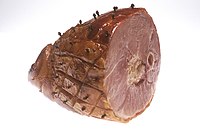
Photo from wikipedia
The objective of this study was to explore the correlation between bacterial communities and volatile compounds in traditional dry sausages from different regions in Northeast China. The bacterial community structure… Click to show full abstract
The objective of this study was to explore the correlation between bacterial communities and volatile compounds in traditional dry sausages from different regions in Northeast China. The bacterial community structure of dry sausages from five different regions as determined by high-throughput sequencing technology demonstrated that Firmicutes and Proteobacteria were the predominant phyla; Lactobacillus, Staphylococcus, Leuconostoc, Lactococcus and Weissella were the predominant genera; and Staphylococcus xylosus, Lactobacillus sakei, Weissella hellenica, Leuconostoc citreum, Lactococcus raffinolactis and Lactobacillus plantarum were the predominant species. Meanwhile, a total of 120 volatile compounds were detected in sausages from five different regions and mainly included alcohols, acids, aldehydes, ketones, esters and terpenes. Furthermore, the potential correlations between the core bacteria and major volatile compounds (64) were explored based on Spearman's correlation analysis. Positive correlations were found between W. hellenica, Lb. sakei, Lactococcus lactis, Lactobacillus alimentarius, Lb. plantarum and carboxylic acids and alcohols. Lc. lactis, Lb. alimentarius and Lb. plantarum were associated with the production of most esters, aldehydes and ketones. This study provides a deep insight into the relationship between the bacterial community and the volatile flavour profile of dry sausages, which may be helpful for the production of fermented dry sausages.
Journal Title: Food microbiology
Year Published: 2020
Link to full text (if available)
Share on Social Media: Sign Up to like & get
recommendations!